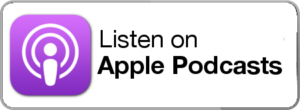I don’t know who coined the term movement is medicine, but it resonates for me. My early experiences with exercise were not joyful; grade school physical education was bad medicine. But once I started dancing with friends in high school – before carding and ID checks were mandatory – I experienced movement in a positive way. Shortly after college I started a yoga practice which was medicine for my body and mind.
In this podcast episode I tell my story of what led up to the 2021 launch of the May Movement Challenge — a month of free online movement classes that are meant to be accessible and adaptive for anyone and everyone.
You’ll also hear from Natalie Graniela – one of the several movement instructors participating in the annual May Movement Challenge. Natalie talks about her gyrokinesis movement practice and working with seniors as well as people with different bodies and abilities.

For more information visit the website: https://maymovementchallenge.com, register for this year’s month of free online movement classes: https://us02web.zoom.us/meeting/register/tZMvd-yhrDsrGNB8RbtdI8mhTYG-_BUJ90mB, and join the Facebook group: https://www.facebook.com/groups/166227591989420
Most of the episode’s transcription:
If you don’t know my story, the short version is that I discovered, I have a rare genetic condition called myotonic dystrophy when I was 36 years old. Discovered because my family – on my mother’s side – didn’t realize that the reason several of the 9 offspring of Albert and Victoria Tarallo died from sudden heart failure in their 50s was due to a condition originally called Steinert’s disease – after some German scientist who identified the genetics – and at some point was inaccurately re-named myotonic dystrophy because of the what most of us consider to be one of the minor symptoms of a multi-systemic disorder. The more major symptoms are debilitating weakness and fatigue which eventually progresses to respiratory problems, heart electrical problems, GI problems, and the use of mobility devices.
Right now, there is no treatment for the overall condition but there’s the use of a plethora of drugs to treat some of the symptoms. I’ve chosen to limit my pharmaceutical intake and have for much of the last 25 years relied on lifestyle choices – things that are within my control – to mitigate my symptoms. Those lifestyle choices include my diet, my exercise, and my attitude.
Just for the record, I use a nebulizer daily with albuterol to help my respiratory system. But that’s it for western modalities of medicine.
My early experiences with EXERCISE, were not joyful. Physical education in elementary school was torture. I grew up in South Florida where I never quite acclimated to the subtropical climate. The PE Teacher – Mr. Stockweather – may have been a Marine although he did drive a mustard-colored VW van so maybe he had a little hippy dippy in him. Everything seemed very competitive, and I was often one of the last kids chosen to be on a team. I was chubby until 4th grade when I went on a self-imposed diet of cottage cheese and yogurt and gave up my love for Chips Ahoy.
We had Mr. Stockweather from 1st to 6th grade. There were lots of running around a track field, box ball, volleyball, climbing ropes, high jump, long jump, and other modified Olympics events but I don’t think the potato sack racing originated in ancient Greece. The only PE class I enjoyed was the square dancing…and even Mr. Stockweather seemed to enjoy it with his straw hat making the calls…dotsey doe and swing that girl around…
PE classes didn’t improve in middle school with the horrific gym clothes requirement of a white polyester one-piece jumper and having to undress in a crowded locker room. I grew hip to the trick of saying I was having a bad period that lasted for days just to avoid the misery of being out in the hot sun playing softball. None of it was joyful.
Coming out as gay in high school was hard but the silver lining was getting into discos in the 70s and dancing with friends. Oh my God…it was fun. No one cared how you danced, and it was so good to move to fun music and feel joy. I continued a steady diet of dancing with friends in college and shortly after I graduated, I was introduced to yoga.
I was maybe 23 years old and took a yoga class at night at a local school. I wasn’t immediately captured but over the years I kept returning to different yoga classes and eventually yoga workshops and conferences. Maybe 15 or so years ago I was in a longitudinal research study at the U of Rochester Neurology department and the Physical Therapist was impressed that my range of movement was remaining steady during my visits over the four years. it was due to my yoga practice. I started telling…anyone who would listen…that yoga was my main treatment modality. Up until COVID, yoga and walking were my main forms of movement. I tried other types of movement too. I worked with a Pilates trainer for a few years, and I remember a tai chi class I tried for a few months but found the arm movement and balance a bit too challenging to derive much enjoyment.
Gradually my yoga practice had changed. It was challenging to go from a standing pose to reclining on the mat. One teacher made a practice of bringing a chair into the studio for me to use. I wasn’t necessarily embarrassed, but I was starting to realize that even gentle yoga classes were no longer appropriate for me.
In 2017 I attended my first Accessible Yoga conference and then another one the following year. And then in early 2019, much to my surprise, I took the Accessible Yoga Teacher Training and was delighted to learn all types of modifications for most of the yoga poses I had been able to do earlier in my life. several of the class participants also had some type of health condition that precluded them from regular yoga classes.
At the time COVID hit I was attending 2 or 3 in-person movement classes each week. I loved these for the physical and emotional benefits as well as for the sense of community they provided for me. Not having access to them was devastating to me because I knew my physical and emotional homeostasis depended on these movement practices.
I can’t recall which came first but the organization BORP – Bay Area Outreach for Recreational Programs – jumped to the internet with classes like Rumba with Tina or Strength Training with Raye Kahn. Through other class participants I was introduced to Dance for all bodies and the Wheelchair Dancers Organization – all three organizations providing accessible and adaptive online movement classes taught by differently-abled instructors. It was incredible and made COVID bearable.
One of my annual traditions had been attending the Abilities Expo in Northern California – which is a national event showcasing vendors and resources of interest to the disability community. I saw that they were going virtual, so I pitched the idea of a presentation about my exercise journey. You can view that presentation. The Expo organizers told me the recorded presentation was well-received and viewed by many. From that experience was the genesis for the May Movement Challenge in 2021.
What is the May Movement Challenge, you ask? It’s a month of free online movement classes that are meant to be accessible and adaptive for anyone and everyone. Many of the instructors are familiar with teaching students with varying levels of abilities while some are new to our community.
I have a few goals with this project – (1) introduce fun movement practices to people who might not otherwise know about adaptive exercise programs; (2) help instructors who are teaching online find a new audience; and (3) expose movement instructors to ways of providing modifications to their movement instructions so that others may benefit as well.
I’ve been impressed with what organizations like BORP, WDO, and Dance for all bodies has done. I know there are other organizations like them but are they online, are they marketing to the larger community outside of their city, region, or country? With Zoom you can adjust the language in the scrolling captions and this feature has really improved through COVID. Although instructors will speak English – since it’s the only language I speak – their words can be simultaneously translated on the screen for any user. That is cool!
I forgot to mention…I intentionally use the word MOVEMENT rather than exercise. Maybe it’s semantics…but…I had a negative experience with exercise in my youth. Movement encompasses more than exercise. Working in your garden, using the vacuum in your home, folding the laundry…these are all types of movement…and they’re all good for you.
Early on in COVID I was introduced to a movement practice called Gyrokinesis. In an email from the Alameda Senior Center there was an announcement for a free gyrokinesis class. I registered, loved the class, and was surprised to find out the instructor, Natalie Graniela, lives in New York City. Who knew how long COVID would last and how the whole idea of online movement classes would continue? I’m grateful that the major scourge has dissipated but thrilled that online movement classes are here to stay. And I continue taking weekly gyrokinesis classes with Natalie.
Natalie participated in the first two May Movement Challenges and I recently met her in person for the second time. Natalie was a professional dancer with the Erich Hawkins Dance Company and is a trainer in gyrokinesis and gyrotonics. She also has years of experience teaching balance, postural therapy, and exercise workshops for the Arthritis Foundation, NYC dept for the Aging, and a variety of senior centers. Here is our conversation:
LISTEN TO THE PODCAST
Are you ready to participate in this year’s May Movement Challenge? You can register as a participant, or fill out a form to be an instructor, at the website.
As a participant you’re registering to attend Saturday sessions. When the weekly class schedule is ready, you’ll receive it through email. Both the Saturday sessions and weekly classes are free; just register with your name and email address.
Movement classes will cover a wide range employing all types of exercise – flexibility, balance, strength, and endurance, or cardiovascular. Each class is 45-minutes long.
Saturday sessions are one hour and include an interactive presentation by a movement instructor on a specific topic, sharing of someone’s personal journey with movement and how it’s helped them physically or emotionally or both. And there will be a random drawing for a prize. In the past prizes have included tickets to online comedy shows, gift certificate with a movement trainer, and a food package from Daily Harvest. You must be present to win.
I hope you’ll spread the word about the May Movement Challenge, join our Facebook group, and move with us through the month of May.






Thanks Leslie – Great interview w/ Natalie, & I look forward to new classes in May!